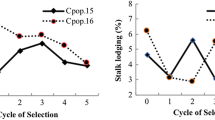Summary
Effectiveness of mass selection for kernel depth in an early maize (Zea mays L.) synthetic, i.e. NDSAB, was evaluated in eight North Dakato environments. Four cycles of selection for deeper kernels were evaluated for grain yield and associated traits by using corresponding randomly selected subpopulations of NDSAB to adjust out inbreeding effects on selected subpopulations. General combining ability (GCA) effects of selected subpopulations also were evaluated for these traits.
Subpopulations selected from one to four cycles for deep kernels were reciprocally crossed to corresponding randomly selected subpopulations in a factorial mating design. Subpopulations, selfed subpopulations, and subpopulation crosses were evaluated for yield and associated traits. Subpopulations selected for deep kernels generally had deeper kernels, higher yields, heavier kernels, more kernel rows per ear, and lower test weights than corresponding randomly selected subpopulations. Differences in GCA effects among selected and unselected subpopulations generally corresponded to differences between selected and unselected parental subpopulations. Inbreeding effects from selfing were observed for all traits, but no average heterosis was detected when subpopulation crosses were compared to parental subpopulations. Reciprocal differences were observed for all traits except kernel depth, but these differences were inconsistent relative to whether deep kerneled females made superior hybrids to unselected females.
Results supported the use of mass selection for kernel depth as a means of grain yield improvement in the short term for NDSAB. However, negative associations of kernel depth with test weight may restrict long term use of this procedure.
Similar content being viewed by others
References
AcostaA. F. & P. L.Crane, 1972. Further selection for lower ear height in maize. Crop. Sci. 12: 165–167.
Cortez-MendozaH. & A. R.Hallauer, 1979. Divergent mass selection for ear length in maize. Crop Sci. 19: 175–178.
CorneliusP. L. & J. W.Dudley, 1974. Effects of inbreeding by selfing and full-sib mating in a maize population. Crop Sci. 14: 815–819.
CrossH. Z., 1977. Interrelationships among yield stability and yield components in early maize. Crop Sci. 17: 741–745.
CrossH. Z., 1983. Registration of NDSAB and NDSF maize germplasm. Crop Sci. 23: 1227.
FalconerD. S., 1960. Quantitative genetics. Ronald Press Company, N.Y. p. 247–254.
GeadelmannJ. L. & R. H.Peterson, 1976. Effects of yield component selection on the general combining ability of maize inbred lines. Crop Sci. 16: 807–811.
GoodR. L. & A. R.Hallauer, 1977. Inbreeding depression in maize by selfing and full-sibbing. Crop Sci. 17: 935–940.
HallauerA. R., 1971. Changes in genetic variance for seven plant and ear traits after four cycles of reciprocal recurrent selection for yield in maize. Iowa State J. Sci. 45: 575–593.
HallauerA. R. & J. B.Miranda, 1981. Quantitative genetics in maize breeding. Iowa State Univ. Press., Ames, IA. p. 460.
HarrisR. E., C. O.Gardner & W. A.Compton, 1972. Effects of mass selection and inrradiation in corn measured by random S1 lines and their testcrosses. Crop. Sci. 12: 594–598.
KuhnW. E. & R. E.Stucker, 1976. Effect of increasing morphological yield component expression on corn single cross yields. Crop Sci. 16: 270–274.
LonnquistJ. H., 1967. Mass selection for prolificacy in maize. Der Züchter 37: 185–188.
ObilanaA. T. & A. R.Hallauer, 1974. Estimation of variability of quantitative traits in BSSS by using unselected maize inbred lines. Crop Sci. 14: 99–103.
SmithO. S., 1979. A model for evaluating progress from recurrent selection. Crop Sci. 19: 223–226.
TroyerA. F. & W. L.Brown, 1972. Selection for early flowering in corn. Crop Sci. 12: 301–304.
Author information
Authors and Affiliations
Additional information
Journal Article No. 1505 of the North Dakota Agric. Exp. Stn., Fargo
Rights and permissions
About this article
Cite this article
Cross, H.Z., Djava, K. Mass selection for kernel depth in early maize. Euphytica 36, 81–90 (1987). https://doi.org/10.1007/BF00730650
Received:
Issue Date:
DOI: https://doi.org/10.1007/BF00730650




